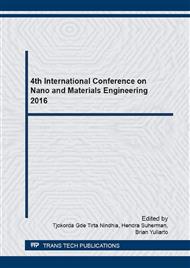[1]
Toxicological Profile for Lead, ATSDR, Ed., ed, (2007).
Google Scholar
[2]
T. Tokimoto, N. Kawasaki, T. Nakamura, J. Akutagawa, and S. Tanada, Removal of lead ions in drinking water by coffee grounds as vegetable biomass, Journal of Colloid and Interface Science, vol. 281, pp.56-61, 1/1/ (2005).
DOI: 10.1016/j.jcis.2004.08.083
Google Scholar
[3]
P. C. Mishra and R. K. Patel, Removal of lead and zinc ions from water by low cost adsorbents, Journal of Hazardous Materials, vol. 168, pp.319-325, 8/30/ (2009).
DOI: 10.1016/j.jhazmat.2009.02.026
Google Scholar
[4]
S. H. Jang, B. G. Min, Y. G. Jeong, W. S. Lyoo, and S. C. Lee, Removal of lead ions in aqueous solution by hydroxyapatite/polyurethane composite foams, Journal of Hazardous Materials, vol. 152, pp.1285-1292, 4/15/ (2008).
DOI: 10.1016/j.jhazmat.2007.08.003
Google Scholar
[5]
N. Gupta, A. K. Kushwaha, and M. C. Chattopadhyaya, Adsorptive removal of Pb2+, Co2+ and Ni2+ by hydroxyapatite/chitosan composite from aqueous solution, Journal of the Taiwan Institute of Chemical Engineers, vol. 43, pp.125-131, 1/ (2012).
DOI: 10.1016/j.jtice.2011.07.009
Google Scholar
[6]
S. H. Abdel-Halim, A. M. A. Shehata, and M. F. El-Shahat, Removal of lead ions from industrial waste water by different types of natural materials, Water Research, vol. 37, pp.1678-1683, 4/ (2003).
DOI: 10.1016/s0043-1354(02)00554-7
Google Scholar
[7]
D. Pham Minh, N. D. Tran, A. Nzihou, and P. Sharrock, Hydroxyapatite gel for the improved removal of Pb2+ ions from aqueous solution, Chemical Engineering Journal, vol. 232, pp.128-138, 10/ (2013).
DOI: 10.1016/j.cej.2013.07.086
Google Scholar
[8]
S. Bailliez, A. Nzihou, E. Bèche, and G. Flamant, Removal of Lead (Pb) by Hydroxyapatite Sorbent, Process Safety and Environmental Protection, vol. 82, pp.175-180, 3/ (2004).
DOI: 10.1205/095758204322972816
Google Scholar
[9]
T. Goto and K. Sasaki, Effects of trace elements in fish bones on crystal characteristics of hydroxyapatite obtained by calcination, Ceramics International, vol. 40, pp.10777-10785, 8/ (2014).
DOI: 10.1016/j.ceramint.2014.03.067
Google Scholar
[10]
B. Kizilkaya, A. A. Tekinay, and Y. Dilgin, Adsorption and removal of Cu (II) ions from aqueous solution using pretreated fish bones, Desalination, vol. 264, pp.37-47, 12/15/ (2010).
DOI: 10.1016/j.desal.2010.06.076
Google Scholar
[11]
M. Boutinguiza, J. Pou, R. Comesaña, F. Lusquiños, A. de Carlos, and B. León, Biological hydroxyapatite obtained from fish bones, Materials Science and Engineering: C, vol. 32, pp.478-486, 4/1/ (2012).
DOI: 10.1016/j.msec.2011.11.021
Google Scholar
[12]
D. Liao, W. Zheng, X. Li, Q. Yang, X. Yue, L. Guo, et al., Removal of lead(II) from aqueous solutions using carbonate hydroxyapatite extracted from eggshell waste, Journal of Hazardous Materials, vol. 177, pp.126-130, 5/15/ (2010).
DOI: 10.1016/j.jhazmat.2009.12.005
Google Scholar
[13]
C. Lee, H. Kim, and J. Kwon, The removal of heavy metals using hydroxyapatite, ENVIRONMENTAL ENGINEERING RESEARCH-SEOUL-, vol. 10, p.205, (2005).
Google Scholar
[14]
A. Hwang, W. Ji, and J. Khim, Characteristics of phosphorus containing waste-bones, Materials Letters, vol. 61, pp.677-679, 2/ (2007).
DOI: 10.1016/j.matlet.2006.05.033
Google Scholar
[15]
M. Okuda, N. Ogawa, M. Takeguchi, A. Hashimoto, M. Tagaya, S. Chen, et al., Minerals and aligned collagen fibrils in tilapia fish scales: structural analysis using dark-field and energy-filtered transmission electron microscopy and electron tomography, Microsc Microanal, vol. 17, pp.788-98, Oct (2011).
DOI: 10.1017/s1431927611011949
Google Scholar
[16]
S. Chattanathan, T. Clement, S. Kanel, M. Barnett, and N. Chatakondi, Remediation of uranium-contaminated groundwater by sorption onto hydroxyapatite derived from catfish bones, Water, Air, & Soil Pollution, vol. 224, pp.1-9, (2013).
DOI: 10.1007/s11270-012-1429-5
Google Scholar


